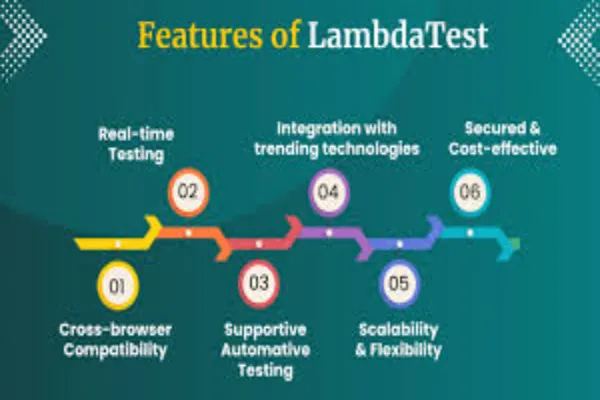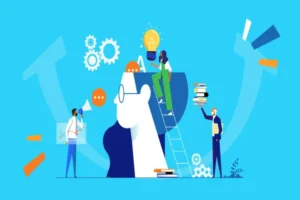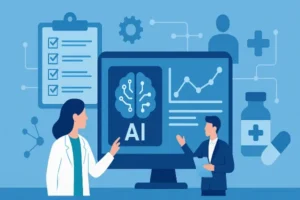AI E2E Testing: How AI is Improving End-to-End Testing Processes

Software testing ensures applications work smoothly before reaching users. End-to-end testing checks every part of a system from start to finish. However, traditional methods can be slow and miss errors. AI E2E testing brings a smarter way to handle this process. By using artificial intelligence, testing becomes faster and more accurate. This blog examines how AI test automation brings better results to end-to-end testing processes. Let’s get started.
What is AI E2E Testing and Why It Matters?
End-to-end testing confirms complete application functionality across every system layer. The application testing process evaluates the user interface and the backend systems while validating its tool connectivity. Doing it manually requires a lot of time and can miss subtle errors. AI E2E testing changes this by using artificial intelligence to automate and enhance the process.
The application behavior patterns help machine learning in AI systems to detect issues swiftly. This method makes testing faster and more reliable than manual human work. Developers can focus on creating features while AI verifies everything functions properly. Businesses benefit by releasing software sooner with higher quality, keeping users satisfied.
As applications become more complicated, traditional testing methods struggle to meet needs. AI test automation adjusts to updates and tests comprehensively with little effort. This adaptability is why teams now choose AI for quality assurance. It cuts down errors and speeds up development timelines. The value of AI in end-to-end testing keeps growing steadily. It supports delivering superior software without delays in progress. For today’s teams, AI E2E testing is essential for success.
How AI Improves Test Case Generation?
End-to-end testing heavily relies on the generation of test cases. Traditionally, testers write scenarios based on requirements and guesswork. This process can miss edge cases or fail to cover real user behavior. AI E2E testing solves this by generating test cases automatically using data.
AI analyzes application usage patterns and historical data to build realistic scenarios. Machine learning models predict where problems might occur and prioritize those areas. This means tests focus on what matters most instead of wasting time on unlikely issues. Testers get a head start with accurate and comprehensive test suites.
Another advantage is that AI updates test cases when the application changes. Manual updates take hours, but AI does it in minutes by learning new features. This keeps testing aligned with development without extra effort. As the software evolves, teams will have confidence that their test coverage remains strong.
AI eliminates human error and makes operations more efficient by automating test case creation. Developers and testers enjoy time savings without sacrificing the application working for the end user. This intelligent approach makes end-to-end testing more reliable than ever before.
Speeding Up Testing with AI Automation
Time is critical in software development cycles. Manual end-to-end testing slows down releases because it requires step-by-step execution. AI test automation speeds up this process by running tests faster than humans can. Artificial intelligence executes multiple scenarios at once across different environments.
AI tools don’t need breaks and can work around the clock. They simulate user actions, check integrations, and validate real-time results. This parallel testing cuts down hours or even days of effort into minutes. Teams can deliver updates to users much quicker.
Beyond speed, AI improves consistency in test execution. Humans might skip steps or make mistakes under pressure. AI follows the same process every time, ensuring dependable outcomes. This reliability helps catch bugs early before they reach production.
Faster testing also supports continuous integration and deployment practices. Developers can push code changes often, knowing AI will verify everything instantly. The result is a smoother workflow that keeps projects on track. Through end-to-end AI testing, the test function will advance from its status as a bottleneck operation to become a valuable strength.
.
How Does AI Enhance Accuracy in End-to-End Testing?
Software testing requires high levels of accuracy alongside speed in its execution. Manual methods struggle to spot subtle defects in complex systems. AI test automation improves accuracy by using advanced algorithms to detect issues. These tools go beyond simple checks and understand application behavior deeply.
AI compares expected results with actual outcomes across every test run. It notices patterns that indicate problems, even if they’re not obvious. For example, machine learning can flag performance slowdowns or integration failures humans might miss. The level of detail assures a better quality final product. Another merit of AI is that it can effectively handle big datasets. Often, end-to-end tests also involve checking data flow within the system. AI validates this flow without getting overwhelmed, catching errors in real-time. Testers gain confidence that nothing slips through the cracks.
Accurate testing reduces the risk of bugs reaching users after release. Businesses avoid costly fixes and maintain their reputation with reliable software. AI E2E testing delivers precision that traditional approaches can’t match consistently.
AI’s Role in Handling Complex Test Scenarios
Software applications in modern times contain various components, including APIs and databases, together with third-party services. Testing these interconnected systems manually is tough and error-prone. AI E2E testing excels at managing complex scenarios with ease. Artificial intelligence understands how different components interact and tests them together. References to industry standards and nosql certifications can further guide teams in ensuring reliability when databases are involved.
AI simulates real-world conditions that stress the application in unique ways. It can mimic heavy user traffic or unexpected inputs to see how the system holds up. This proactive approach finds weaknesses before they cause problems in production. Teams get a clear picture of reliability under pressure.
Handling complexity also means adapting to changes across the system. When an API updates or a database shifts, AI adjusts tests automatically. Manual testers would need to rewrite scripts, but AI learns and moves forward quickly. This saves effort and keeps testing thorough.
Complex scenarios no longer slow down development with AI in play. Testers can tackle challenging integrations without extra resources. AI test automation makes sure every piece of the puzzle fits perfectly.
How Does AI Reduce Testing Costs?
Manual testing and lengthy test cycles make software testing an expensive affair. Added to it, hiring testers and addressing bugs late in development also significantly increases the overall project’s expenses. On the other hand, AI-powered end-to-end testing reduces costs as it automates all repetitive tasks and detects issues early. This allows businesses to improve efficiency while minimizing spending.
AI reduces the need for large testing teams to handle end-to-end checks. One tool can do the work of many people, running tests nonstop. This efficiency lowers overhead and frees up the budget for innovation. Companies stay competitive without breaking the bank.
Early bug detection is another cost-saving feature AI brings to the table. Fixing problems in development is cheaper than fixing them after release. AI spots defects before they escalate, reducing rework and support expenses. Quality improves without extra investment.
By streamlining testing, AI helps teams do more with less. Resources stretch further, and projects finish on time. AI test automation turns an expensive process into an affordable advantage.
How Can Teams Overcome Challenges in AI Test Automation?
AI test automation comes with challenges that organizations can effectively handle. One challenge is setting up AI tools to fit specific applications correctly. Teams need to train models with the right data for accurate testing. This takes some initial effort but pays off long term.
Another issue is trusting AI to handle critical testing tasks fully. Some worry it might miss unique bugs or misjudge results. Combining AI with human oversight solves this by blending automation with expertise. Testers guide AI while it does the heavy work.
Integration with existing tools can also be tricky at first. Legacy systems might not connect easily with modern AI platforms. However, most AI solutions offer flexible options to bridge this gap. Teams adapt over time and see smoother workflows.
These challenges do not devalue the benefits of AI in E2E testing. Teams overcome obstacles with the right approach, unlocking the most potential AI has to offer. The result is a testing process that’s stronger and more efficient.
Future of AI in End-to-End Testing
The evolution of AI E2E testing promises even brighter possibilities for software quality. AI is becoming increasingly intelligent with its machine learning and data analysis advancements. This means testing tools will soon predict bugs before they happen by studying trends. Developers can fix issues proactively instead of reacting to failures.
AI will also integrate more deeply with development pipelines over time. As teams adopt DevOps practices, AI test automation will run seamlessly alongside the coding and deployment stages. This tight connection ensures every update gets tested instantly without slowing progress. Software releases will become faster and more reliable.
Another exciting shift is AI personalizing tests for specific user needs. By analyzing how people use applications, AI can focus on real-world scenarios that matter most. This makes testing practical and user-centered, improving satisfaction. The future holds a testing process that’s not just efficient but also intuitive.
These advancements show AI’s potential to redefine end-to-end testing completely. Teams that embrace this evolution will stay ahead in delivering top-notch software. The journey of AI in testing is just beginning.
LambdaTest: Powering Faster AI E2E Testing with Seamless Integration
LambdaTest is an AI-Native test orchestration and execution platform that lets you perform manual and automated tests across 5000+ real devices, browsers and OS combinations.
This platform is designed to speed up software delivery. Businesses using this tool can cut down the time to market by running tests quickly across thousands of environments.
This platform makes AI E2E testing simple by offering parallel testing capabilities. Running multiple tests at once across various devices significantly slashes execution time. Testers can rely on LambdaTest’s secure and scalable infrastructure to handle large projects without worry. Plus, it connects smoothly with popular tools, letting teams start testing fast without complicated setups.
Debugging becomes easier with features like video recordings, network logs, and console logs. These tools help spot and fix issues quickly, improving software quality. LambdaTest provides a huge lab of real Android and iOS devices for mobile testing. This ensures AI test automation covers every scenario, delivering reliable releases every time. LambdaTest empowers teams to achieve faster, high-quality outcomes effortlessly.
Conclusion
AI E2E testing transforms end-to-end testing by making it faster, more accurate, and cost-effective. From generating smart test cases to handling complex scenarios, AI test automation saves time and boosts quality. It reduces manual effort while ensuring that the software works flawlessly for users. Embracing this technology helps teams deliver better applications with confidence. How will you use AI to improve your testing process?






